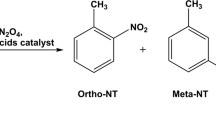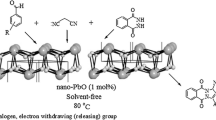Abstract
The Box–Behnken experimental design has been applied to establish the optimized conditions for the synthesis of 2-amino-4,5-dihydro-5-oxo-4-phenylpyrano[3,2-c]chromene-3-carbonitrile over ZnO nano-particles as catalyst. ZnO nano-particles were prepared using the homogeneous precipitation method and 2-amino ethanol as precipitating agent. Three factors, three level Box–Behnken response surface design has been investigated using process parameters such as catalyst (0.05–0.5 mmol), solvent (5–20 mL) and temperature (50–90 °C). The results of the experiments were fitted to two quadratic polynomial models developed using response surface methodology, representing the functional relationship between the time and the yield of products and the experimental parameters. The predicted time and yield for optimal condition is 3.2 h and 94.6 %, respectively.







Similar content being viewed by others
References
Foye WO (1991) Principi Di Chimica Farmaceutica. Piccin, Padova, p 416
Andreani LL, Lapi E (1960) Aspects and orientations of modern pharmacognosy. Bull Chim Farm 99:583–586
Bonsignore L, Loy G, Secci D, Calignano A (1993) Synthesis and pharmacological activity of 2-oxo-(2H) 1-benzopyran-3-carboxamide derivatives. Eur J Med Chem 28:517–520
Witte EC, Neubert P, Roesch A (1986) 7-(Piperazinylpopoxy)-2H-1-benzopyran-2-ones. Ger. Offen DE., 1986; 3427985. Chem Abstr 104:224915f
Ellis GP (1977) Chapter II. In: Weissberger A, Taylor EC (eds) The chemistry of heterocyclic compounds chromenes, chromanes and chromones. Wiley, New York, pp 11–139
Hafez EA, Elnagdi MH, Elagemey AGA, El-Taweel FMAA (1987) Nitriles in heterocyclic synthesis: novel synthesis of benzo[c]coumarin and of benzo[c]pyrano[3,2-c]quinoline derivatives. Heterocycles 26:903–907
Abdou MM, El-Saeed RA, Bondock S (2015) Recent advances in 4-hydroxycoumarin chemistry. Part 2: scaffolds for heterocycle molecular diversity. Arab J Chem. doi:10.1016/j.arabjc.2015.06.029
Laskar S, Brahmachari G (2014) Access to biologically relevant diverse chromene heterocycles via multicomponent reactions (MCRs): recent advances. Signpost Open Access J Org Biomol Chem 2:1–50
Slobbe P, Ruijter E, Orru RVA (2012) Recent applications of multicomponent reactions in medicinal chemistry. Med Chem Commun 3:1189–1218
Shankar Singh M, Chowdhury S (2012) Recent developments in solvent-free multicomponent reactions: a perfect synergy for eco-compatible organic synthesis. RSC Adv 2:4547–4592
Mobinikhaledi A, Yazdanipour A, Ghashang M (2015) Green synthesis of 2-amino-7-hydroxy-4-aryl-4H-chromene-3-carbonitriles using ZnO nanoparticles prepared with mulberry leaf extract and ZnCl2. Turk J Chem 39:667–675
Ghashang M, Mansoor SS, Aswin K (2014) Thiourea dioxide: an efficient and reusable organocatalyst for the rapid one-pot synthesis of pyrano[4,3-b]pyran derivatives in water. Chin J Catal 35:127–133
Behmaneshfar A, Ghashang M, Mohammad Shafiee MR, Saffar-Teluri A, Fazlinia A, Esfandiari H (2015) Optimization of the preparation condition of 2,4,5-triphenyl-1H-imidazole over BaSO4 nanoparticles as catalyst using a response surface methodology (RSM). Curr Nanosci 11:56–63
Khuri AI, Cornell JA (1996) Response surfaces, 2nd edn. Dekker, New York
Box GEP, Behnken DW (1960) Some new three level designs for the study of quantitative variables. Technometrics 2:455–475
Gardiner WP, Gettinby G (1998) Chapter 11. In: Experimental design techniques in statistical practice: a practical software-based approach. Woodhead Publishing, Chichester, pp 322–354
Cristóvão RO, Amaral PFF, Tavares APM, Coelho MAZ, Cammarota MC, Loureiro JM, Boaventura RAR, Macedo EA, Pessoa FLP (2010) Optimization of laccase catalyzed degradation of reactive textile dyes in supercritical carbon dioxide medium by response surface methodology. Reac Kinet Mech Cat 99:311–323
Moradi G, Mohadesi M, Hojabri Z (2014) Biodiesel production by CaO/SiO2 catalyst synthesized by the sol–gel process. Reac Kinet Mech Cat 113:169–186
Shaabani A, Ghadari R, Ghasemi S, Pedarpour M, Rezayan AH, Sarvary A, Weng Ng S (2009) Novel one-pot three- and pseudo-five-component reactions: synthesis of functionalized benzo[g]- and dihydropyrano[2,3-g]chromene derivatives. J Comb Chem 11:956–959
Ghashang M, Kargar M, Mohammad Shafiee MR, Mansoor SS, Fazlinia A, Esfandiari H (2015) CuO nanostructures prepared in Rosmarinus officinalis leaves extract medium: efficient catalysts for the aqueous media preparation of dihydropyrano[3,2-c]chromene derivatives. Rec Pat Nanotech 9:204–211
Acknowledgments
We are thankful to the Najafabad Branch, Islamic Azad University Research Council for partial support of this research.
Author information
Authors and Affiliations
Corresponding author
Rights and permissions
About this article
Cite this article
Baziar, A., Ghashang, M. Preparation of pyrano[3,2-c]chromene-3-carbonitriles using ZnO nano-particles: a comparison between the Box–Behnken experimental design and traditional optimization methods. Reac Kinet Mech Cat 118, 463–479 (2016). https://doi.org/10.1007/s11144-016-1013-x
Received:
Accepted:
Published:
Issue Date:
DOI: https://doi.org/10.1007/s11144-016-1013-x




